Mumbai Railways: The Great Leveler
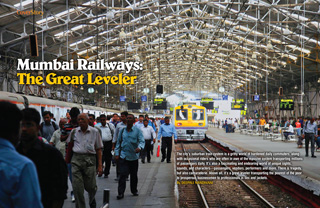
The city’s suburban train system is a gritty world of hardened daily commuters, along with occasional riders who are often in awe of the massive system transporting millions of passengers daily. It’s also a fascinating and endearing world of unique sights, sounds, and characters—passengers, vendors, performers and more. There is tragedy, but also camaraderie. Above all, it’s a great leveler transporting the poorest of the poor to prosperous businessmen to professionals in ties and jackets.
ANDHERI अंधेरी GOREGAON गोरेगांव
MULUND मुलुंड VASHI वाशी
THANE ठाणे WADALA वडाला ...
|
|
|
A sea of humanity during rush hour at Churchgate Station. (Photos: Suraj Gauda)
.jpg)
(Left) Someone trying to catch the train as it leaves the platform. (Photo: Suraj Gauda).
The evening rush hour at Churchgate Station on the Western line of Mumbai’s local rail system is no place for the feeble-bodied or feeble-hearted. The last stop at the southern end, it is from Churchgate Station that tens of thousands of commuters head back from downtown to their suburban homes, causing a daily scene of utter chaos, clamor, and unimaginable crowds rushing to board a just-arrived train. The hustle to get in is nothing less than bone-crushing as humans pack in like sardines to a point that passengers are bulging out of the open doors of the compartment when the train leaves the station. Incredibly, this is a scene that repeats every 2 to 3 minutes—the frequency of the trains during rush hour.
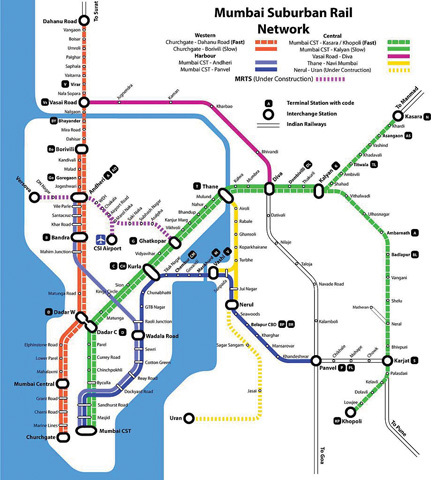
(Left) A massive network that that adds up to over 400 kilometers, runs over 2,500 train services per day, and transports over 8 million passengers per day!
By any measure, the scale of this metro transit system—one of the world’s largest—is astounding. Between its three main veins—the Western, Central, and Trans-Harbor Lines—along with a couple of other smaller lines, there are over 2,500 train services every day traversing the local network that adds up to over 400 kilometers. Close to 8 million passengers—almost twice the population of Atlanta—are transported every day! Not bad for a system famous for its almost around-the-clock service: the lines are closed only from 2:30am to 4:15am.
The lifeblood of the city
Mumbai would cease to exist as India’s financial
capital if its extensive suburban railway system were
taken out of the picture. The massive network, divided
into several zones, works with clockwork precision
all through the year—except during the notorious
monsoons, when inevitably Mumbai’s throbbing
trains are forced out of commission at least a couple
of times per season.
The rest of the time, these trains are simply overworked. The official count of passengers is supposed to be 1,700 per train, but the unofficial, as the railway authorities admit, could be as high as 5,000 per train— despite the fact that a train runs every 2 to 3 minutes during rush hour, and about 4 to 5 minutes during offpeak hours.
It is easy to see why this suburban railway system is not just among the most efficient, but also Mumbai’s very salvation, the artery that keeps the city moving. Every morning and evening, a restless sea of humanity rushes like an uncontrollable wave towards the trains, pushing each other in and out of the train cars, hanging often by a slim thread. In non-rush hours, it eases up just a bit.
|
|
|
The prolific shoeshine fellows are practically the mascots of Mumbai’s rail stations. (Photos: Suraj Gauda)
Some of the afternoon rides settle into a nice rhythm where one can actually get a seat and see outside the windows and the open compartment doors. It’s a great time for people-watching—inside the train and more so on the passing stations, which are spaced out just minutes apart. Every station has shops and vendors selling just about everything, including staples for a train ride such as newspapers, magazines, and books. The hardy shoeshine fellows who give your dusty shoes a shining makeover for a measly Rs.10 are practically the mascots for these railway stations.
|
|
|
|
A vendor selling trinkets. These “mobile markets on wheels,” where vendors go from compartment to compartment selling their wares offer employment to scores of small vendors who have no money to put down on a permanent shop. |
One of Mumbai’s famous dabbawalas on the go. (Photo: Tejas Magade) |
.jpg)
(Left) Carrying heavy loads is common, whether it is passengers, vendors, or porters. (Photo: Tejas Magade)
The trains themselves are mobile markets where vendors go from compartment to compartment selling their wares: food, chai, cold drinks, toys, trinkets, stationery, books, and even vegetables, which some women buy and chop in the train itself, in preparation for the next meal.
“I have bought so much on the trains—a bag from Thailand for a mere Rs 700, and a beautiful shell necklace,” says journalist Divya Das. These mobile markets offer employment to scores of small vendors who have no money to put down on a permanent shop.
Another breed of regulars are the performers—singers, musicians, fortune-tellers, and such—surviving on the few rupees they earn from passengers for their unique talents.
.jpg)
The “Maximum City,” as author Suketu Mehta has coined Mumbai, is full of stark contrasts, none more than the contrast between rich and poor. The local trains are a boon to the day laborers, hawkers, and many who subsist day to day—in the same city that boasts the world’s most expensive residence, Mukesh Ambani’s “Antilia,” valued at over $2 billion. Such are the contrasts of this metropolis. And it is this contrast that spills into Mumbai’s trains, the city’s great leveler. Even the rich who may have an Audi or a BMW in their garages often succumb to using the train, albeit, the first-class coaches, as it gets them to their destinations faster than their fancy cars, which are reduced to no more than go-carts chugging along at snail’s pace on Mumbai’s perennially congested roads during peak traffic.
|
|
|
Daily commuters feel at home in these trains. Here are some catching up on sleep. (All photos: Suraj Gauda)
It is hard to imagine that the same train which during rush hour is a harrowing ordeal of mad rush, jostling, and the suffocating claustrophobia of being squeezed in with a sea of people, can also be a place of deep peace and rest … just change the time from rush hour to late evening. A night ride in these trains with nearly empty coaches, a cool breeze from its open windows and doors, and the rhythmic chugging of the train can put one into a welcome trance. Many Mumbaikars will swear that some of the best sleep they have had is on its local trains.
.jpg)
(Left) Walking along and across the rails is quite common. (Photo: Suraj Gauda)
.jpg)
The gritty and the grim
As if the bone-crushing rush hour were not gritty
enough, the world of Mumbai trains has its share of
the bleak. Along the stations and around it, poverty
is quite visible: the down-and-out with their ragged clothes, probably worn for weeks at length; skinny bodies doing the hard labor of carrying weight twice their size; rag pickers scavenging the rail tracks.
Disrepair, dirt, and debris is a common sight around some of the stations. The trains cut through some of Mumbai’s ugly underbelly where sights of squatters, slums, shanties, and dilapidated old buildings is quite common—a stark contrast from Mumbai’s posh
areas like Marine Drive, Bandra, Malabar Hill and
others where one can dine on some of the finest international cuisines.
(Left) Disrepair, dirt, debris, and hard labor are some of the bleak sides of this world. (Photo: Suraj Gauda)
Many stations on the Western line are very old and have never been renovated. Two over bridges meant for foot traffic to cross the rail lines collapsed last year, causing several fatalities and injuries.
|
|
|
|
A young man climbs over a metal fence to board. |
Someone has just disembarked from a moving train. |
Risky moves are synonymous with Mumbai trains.
Perhaps the grimmest statistic of this potentially perilous rail system is this: According to the Government Railway Police (GRP), there are, on an average, eight fatalities every day throughout the Mumbai rail system. Some die slipping in the gap between the train and the station while climbing a horribly crowded train; many, because they fall off from crowded compartments while standing practically on their toes on the footboard, because there is no space to get in.
.jpg)
The fatalistic “sport” of train surfing. (Photo Suraj Gauda)
Many others die while train surfing, another peculiar phenomenon on the network. It’s a “sport” in which fatalistic young daredevils hang way out of the compartments to high-five oncoming metal posts, and even to jump from the moving train onto the dividing wall separating the tracks. They risk death for a few exhilarating minutes of adrenaline rush—presumably to deal with the stress of their seemingly hopeless lives. “We live in small huts, in dirty slum colonies, where we are often packed eight to a home,” says 16-year-old train surfer Nadeem Sheikh. “How do you deal with this kind of life? You look for adventure. We believe life is just to be lived in this moment. We hardly have a future, so why worry about tomorrow?”
While Sheikh and his ilk look for trouble, there are some who face lifelong handicap because of the death trap that Mumbai trains can sometimes be because of its sheer volume of people hustling and jostling over each other. Twenty-six-year-old Raushan Jawwad lost both her legs in a train accident nine years ago. “I still remember the day when I fell. One minute, I was standing on the footboard, the other, I was tumbling down. I felt a searing unbearable pain when the train wheels went over me. When I regained consciousness, I had lost both my legs,” she recalls.
Thanks to the risks of travelling in Mumbai trains, leading insurance company Bajaj Finserv has introduced the ‘Mumbai Local Train Cover,’ an insurance policy that provides coverage in case of mishaps during a train journey, which has often led to the death of sole breadwinners of families.
A brighter future
The railway authorities have been working incessantly
to improve the network. A new blue light on the
coach door will signal that the train is starting, offering
people an adequate warning in a bid to reduce the
number of accidents.
.jpg)
(Left) Overcrowding: The seats were made to officially carry 3 passengers, but 4 has become the norm. (Photo: Tejas Magade)
The 9-carriage trains have been scaled up to 12- and 15-carriage trains, and there is still room for expansion, considering the platforms can handle 18 carriages. This has helped ease the overcrowding to some extent. New state-of-the-art railway stations have been planned and some are under construction.
A year ago, the Indian Railways started air-conditioned trains on the Western network, offering Mumbai a far more comfortable and quicker mode of transport. So far, two fully air-conditioned trains have been introduced, which run multiple times throughout the day during each of the rush hours. This has been an exceptional relief to the white collar office workers who don’t want to get to office all sweaty. More AC trains are expected to be inducted to the fleet and there are also studies being conducted on feasibility of adding specific air-conditioned compartments to every train.
Despite its gritty side, Mumbai trains are quite safe. The crime rate is low. Police guards and sniffer dogs are at major stations, and there is a police station on almost every station. No wonder Mumbai women feel safe traveling alone on these trains even late into the night.
Then there is the Mumbai Metro, the newer rapid transit system that opened in 2014, of which only one route that connects the western and eastern suburbs is complete. So large has Metro’s impact been on the lives of Mumbaikars, that now an audacious project of laying out at least four different routes across and under one of the densest cities of the world is underway. It’s a project that is ambitious and contentious. It slices through the city’s few surviving green lungs which Mumbaikars are fighting fiercely to protect. But that’s another story.
An incubator for friendships and
relationships
Fortunately the fascinating and endearing side of the world of Mumbai trains far outweighs its dark side.
.jpg)
(Left) The ladies compartment. While men are not allowed in these, women are okay to board any compartment. (Photos: Tejas Magade)
Given the number of hours Mumbaikars spend in their local train, friendships are forged and romance brews. Kapil Gupta, an architect, met his future wife on platform no. 4 of Andheri Station on the western network. “I noticed this pretty girl walking down the staircase and waiting near the ladies compartment at 9 in the morning a couple of times,” he tells me, sipping a cutting chai (tea) from a glass tumbler. In the cramped quarters of Mumbai’s trains, it is customary for men and women to travel in separate compartments.
“I liked her and so I changed my timing from 9:30am to 9am just so I could try and meet her,” he says. They began by acknowledging each other with a nod since they saw each other every day at the station, and one day he picked up the courage to strike up a conversation. “We began meeting up every day,” says Mansi, now his fiancée. “We decided to get married after a year of knowing each other and travelling together.” The railways have bolstered many a spirited romance; this was beautifully depicted in the 1979 Tina Munim and Amol Palekar-starrer, Baton Baton Mein, in which part of the love story plays out in a train compartment.
Often, lifelong friendships are formed on these trains. I have met two of my closest friends on the 10:30am train from the suburban station of Malad to Churchgate. We have chatted through the hour-long journey, exchanging notes on family and friends, work and bosses; we have met outside for long lunches and breezy brunches, and for movie dates. But the railway system remains a leitmotif of our friendship; we call ourselves each other’s ‘train friends.’ Women, particularly, develop close bonds, often discussing intimate personal matters, exchanging beauty notes, and more.
.jpg)
(Left) Women often hang out precariously from the compartment.
Divya Thakur, a 47-year-old lawyer who takes an early morning train to Grant Road, a colonial-era railway station, talks fondly about the group of 10 who take the same train every morning. “We sing, we celebrate festivals, we gossip, and we make plans to meet outside on a weekend,” she says. “We often eat our breakfast on the train, each of us bringing a separate dish and digging into each other’s dabbas.” The friendships that people develop are so thick that you will find women often offering their seat to another in the group of friends halfway through the journey. And that is a big deal, because in the long, packed-to-the-gills network, where women often hang out precariously from the compartment, offering someone a hard-won seat is a mark of true friendship.
.jpg)
(Left) Commuters make friends, play games, .. and sleep. (Photo: Suraj Gauda)
Many daily commuters form groups surrounding their interests. There are bridge clubs, teen patti (an Indian form of poker) players, music groups, bhajan and kirtan groups, and even gambling “gangs” that bet on everything from cricket games to whether or not the latest Bollywood flick will cross over Rs. 1 crore in box office sales. There is palpable comradery amongst these folks, many of whom also end up being good friends outside their train world.
Eight million daily travelers … eight million stories … some pathos, but a lot of good old grit, resilience, graciousness, and warmth of the Mumbaikars—the Mumbai local train system is befittingly a microcosm—albeit a massive one—of the city itself.
Deepali Nandwani is a Mumbai-based freelance journalist, a columnist on luxury with CNBC-TV18, and an aficionado of everything heritage.
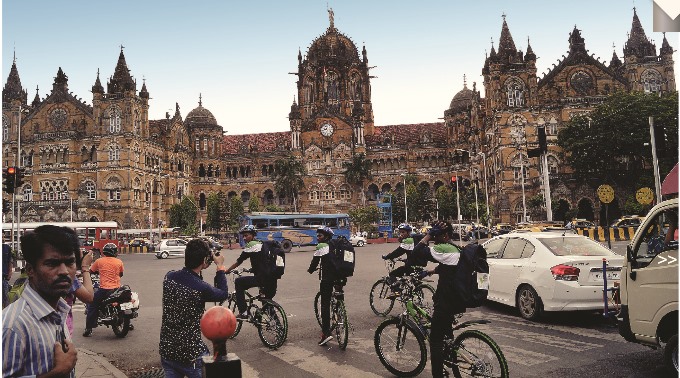
The Chattrapati Shivaji Terminal, previously known as Victoria Terminal, is not only an important junction, but also one of Mumbai’s famous landmarks. (Photo: Tejas Magade)
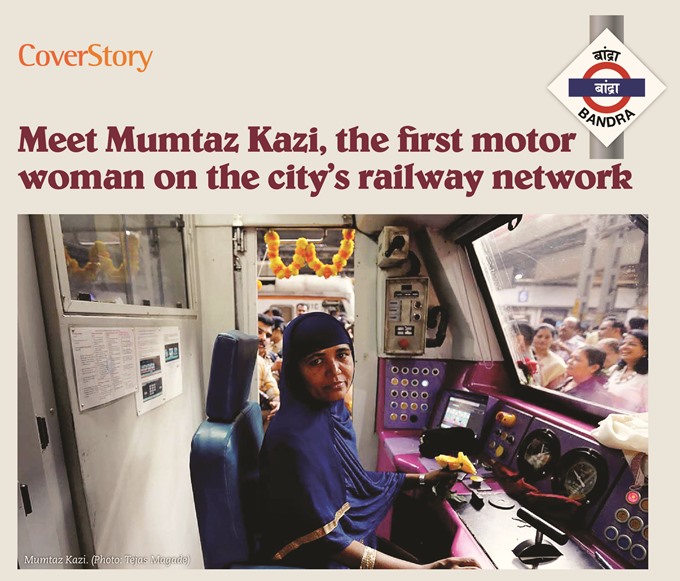
It seems like just another day. The Chhatrapati Shivaji Maharaj Terminus, formerly known as the Victoria Terminus—a UNESCO World Heritage Site built in 1888, a grand reminder of the British Raj and a sweeping architectural statement of Victorian Gothic Revival architecture—is overflowing with people. A few wait patiently for the next train to chug in, its trademark yellow-and-brown engine followed by a long trail of white-and-purple compartments. A few are at the little food stores that dot the front of the station. Some, who have just disembarked from trains that have pulled into the station, hurry to their destination.
Suddenly, a murmur rises and then picks up. The excitement is palpable and very unusual as people stop by at the motorman’s cabin of this train. Mumbaikars can rarely be seen stopping at their train stations; they are too much in a hurry to get somewhere.
“Look, I told you, I saw her yesterday!” squeaks a young 18-year-old girl with a backpack on her shoulders. Her friend turns around to stare. From the narrow driver’s compartment emerges a woman dressed in an indigo blue salwar kameez and tightly wound hijab. Manoj Pawar, a young man in his 20s, steps forward to speak with her and click a selfie. She is Mumtaz Kazi, the first motor woman on the city’s railway network. What startles people today, even 27 years after she first drove that goods train into history books, is not just that she is a woman, but that she also wears a hijab and is yet considered a game-changer in the century-old rail system.
Kazi was 20-years-old when she decided to take up her fantasy job. Her love affair with the railways began when, as a child, she heard stories about trains and locomotives and stations where people not just caught up with friends and college mates, but took a break to savor their favorite street food or just hung around. “I remember the first day at the Kural Training School. I was the only woman among 50 men. My father was worried about my decision and spoke to the instructor, Bhupendra Singh ji, who assured him that he will look after me like his daughter.”
And he did. In September 1991, Kazi joined the Central Railways and has, since then, moved up from the position of a goods train driver to the city’s first motor woman. There are several women who have joined the league of motor women since then. But even today, when Kazi’s train chugs into VT station, a gaggle of commuters—women in their starched saris or business suits, men with their backpacks, young people with time to spare in between college—stop over at the motor woman’s cabin to exchange pleasantries or simply request her for a selfie.
Among them is Purvi Seth, who is fascinated by Kazi because “I never thought I would see a woman in a hijab driving a train. It can happen only in Mumbai. In this city, it doesn’t matter what you wear, where you come from. What matters is what you achieve. It is also the only city where every woman can hope to achieve something.”

One of the most enduring icons of Mumbai are the dabbawalas who carry tens of thousands of lunchboxes filled with home-cooked meals from people’s homes to their offices. They have been extensively studied and lauded for their efficiency, work culture, and punctuality. The Mumbai trains, offering the fastest way to traverse around the city, are crucial to these dabbawalas. Every morning, on the various railway platforms across the network, you will see the hardy dabbawalas with their color-coded, four-tiered stackable cylindrical lunchboxes. The number on the boxes and color codes tell them the exact destination of the lunchbox. Right at the end of the train is a special luggage compartment reserved just for them. Over 5,000 dabbawalas deliver almost 300,000 lunchboxes across the swath of Mumbai’s office network, fanning out in different directions. And this is possibly only because of the city’s robust train system.
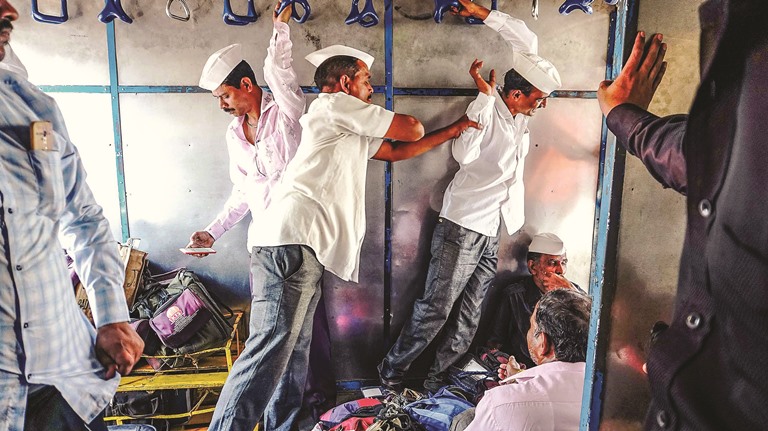
The dabbawalas get their own separate compartment. (Photo: Tejas Magade)

Enjoyed reading Khabar magazine? Subscribe to Khabar and get a full digital copy of this Indian-American community magazine.
blog comments powered by Disqus




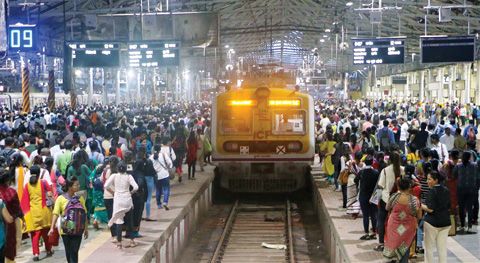
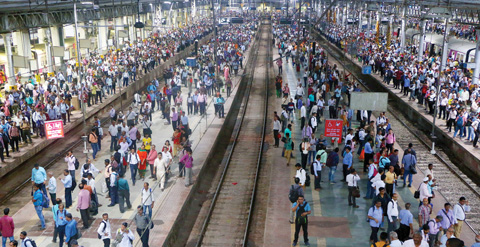
.jpg)
.jpg)
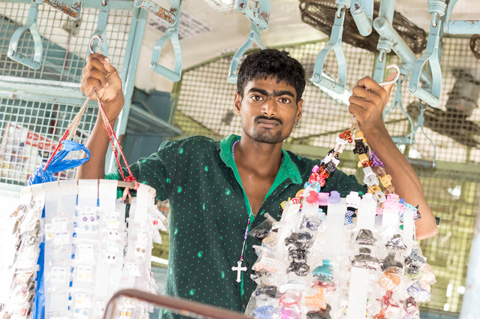
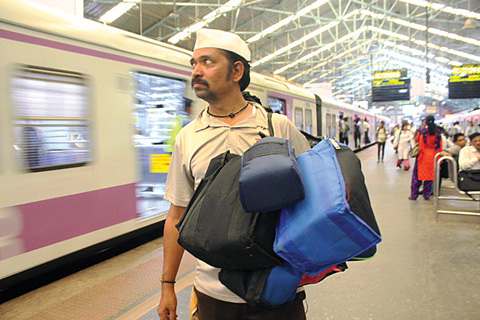
.jpg)
.jpg)
.jpg)
.jpg)






